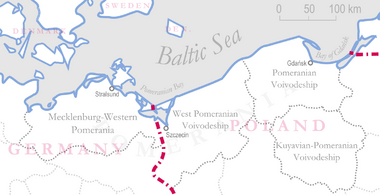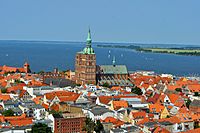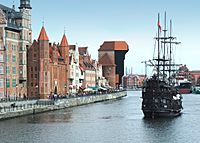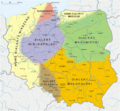Pomerania facts for kids
Quick facts for kids
Pomerania
Pomorze, Pommern, Pòmòrskô
|
||
|---|---|---|
|
||
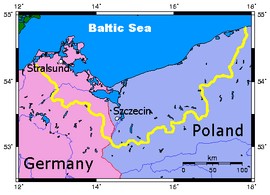 |
||
| Countries | ||
| Largest city | Szczecin | |
| Demonym(s) | Pomeranian | |
| Time zone | UTC+1 (CET) | |
| • Summer (DST) | UTC+2 (CEST) | |
Pomerania (Polish: Pomorze; German, Low German and North Germanic languages: Pommern; Kashubian: Pòmòrskô) is a historical region on the southern shore of the Baltic Sea in Central Europe, split between Germany and Poland.
The name derives from the Slavic po morze, meaning "by the sea" or "on the sea". Pomerania stretches roughly from the Recknitz and Trebel rivers in the west to the Vistula river in the east.
The largest Pomeranian islands are Rügen, Usedom/Uznam and Wolin. The largest Pomeranian city is Gdańsk, or, when using a narrower definition of the region, Szczecin. Outside its urban areas, Pomerania is characterized by farmland, dotted with numerous lakes, forests, and towns. The region was strongly affected by post–World War I and II border and population shifts, with most of its pre-war inhabitants leaving or being expelled after 1945.
Contents
Geography
Borders
Pomerania is the area along the Bay of Pomerania of the Baltic Sea between the rivers Recknitz and Trebel in the west and Vistula in the east. It formerly reached perhaps as far south as the Noteć river, but since the 13th century its southern boundary has been placed further north.
Landscape
Most of the region is coastal lowland, being part of the Central European Plain, but its southern, hilly parts belong to the Baltic Ridge, a belt of terminal moraines formed during the Pleistocene. Within this ridge, a chain of moraine-dammed lakes constitutes the Pomeranian Lake District. The soil is generally rather poor, sometimes sandy or marshy.
The western coastline is jagged, with many peninsulas (such as Darß–Zingst) and islands (including Rügen, Usedom, and Wolin) enclosing numerous bays (Bodden) and lagoons (the biggest being the Lagoon of Szczecin).
The eastern coastline is smooth. Łebsko and several other lakes were formerly bays, but have been cut off from the sea. The easternmost coastline along the Gdańsk Bay (with the Bay of Puck) and Vistula Lagoon, has the Hel Peninsula and the Vistula peninsula jutting out into the Baltic.
Prehistoric times, Germanic and Slavic tribes
20,000 years ago the territory of present-day Pomerania was covered with ice, which did not start to recede until the late period of the Old Stone Age or Paleolithic some 10,000 years BC, when the Scandinavian glacier receded to the north. Various archaeological cultures developed in the Mesolithic, Neolithic, Bronze Age, and Iron Age.
Since around 500BC and before 500 AD Pomerania was dominated by East Germanic tribes including several tribes of Goths, who according to archeological evidence and their own tradition have come from Scandinavia. Goths and Rugians are recorded by Roman historians in the areas of Pomerania in 98 AD. The Veneti, non-Germanic tribe, which later assimilated with Slavs, are recorded by Ptolemy and Pliny the Elder around Vistula in first century AD. By the 7th century Slavic tribes (Wends) such as the Pomeranians settled the area.
Pomerania as a part of Poland, Denmark and Germany; German settlement
Pomerania was first conquered by the Polish duke Mieszko I in the second half of the 10th century. Pagan uprisings in 1005 and 1038 resulted in independancy for Western Pomerania and Pomerelia, respectively. Regained by Poland in 1116/1121, the Polish could not hold the Pomeranian duchy longer than 1135, whereas Pomerelia after the 1138 partition of Poland among the sons of Boleslaus Wrymouth became a part of the Polish seniorat which was declared fief of the Holy Roman Empire in 1156.
The Western part, the Duchy of Pomerania, was declared part of the Holy Roman Empire (1181). After a brief period of Danish rule (1168/1186-1227), it remained part of Holy Roman Empire of the German Nation until 1806.
1000 years of history of the areas between Elbe, the Oder and Vistula 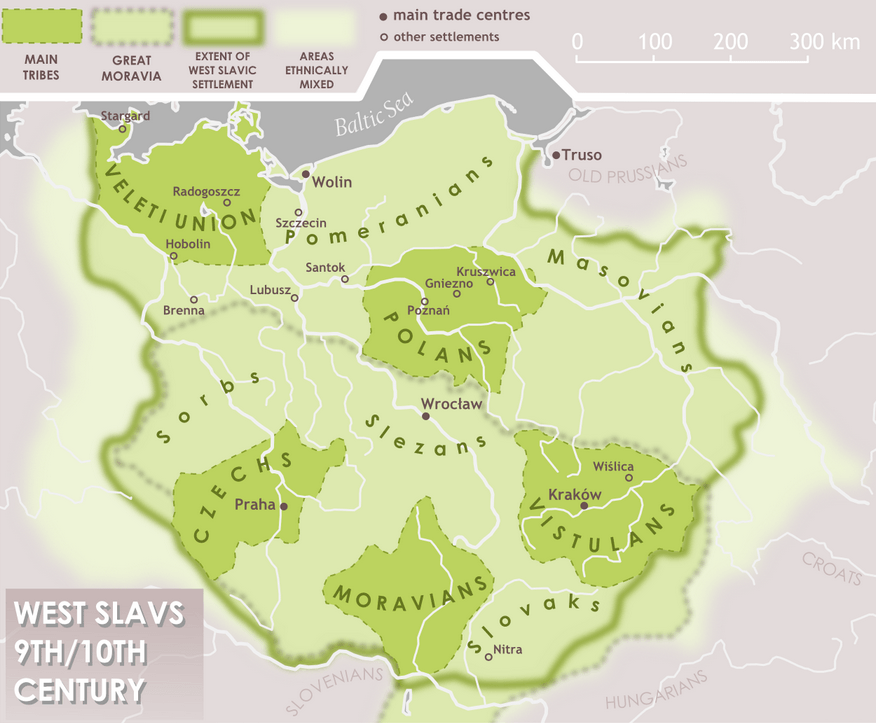

Cities and towns with more than 50,000 inhabitants
Cities in the historical region of Pomerania (with population figures for 2012):
- Szczecin (West Pomeranian Voivodeship, 408,913; up to 763,321 in the metropolitan area)
- Stralsund-Greifswald high level urban center of Mecklenburg-Vorpommern (population 113,128), including:
- Stralsund (57,357)
- Greifswald (Low German: Griepswohld) (55,771)
- Koszalin (West Pomeranian Voivodeship, 109,343)
- Słupsk (Pomeranian Voivodeship, 94,849)
- Stargard (West Pomeranian Voivodeship, 69,724)
Other cities in the Pomeranian and Kuyavian-Pomeranian voivodeships:
- Tricity metropolitan area (Pomeranian Voivodeship) (population in 2012: at least 1,035,000; area 1,332,51 km2), including:
- Toruń (Kuyavian-Pomeranian Voivodeship, 205,934)
- Grudziądz (Kuyavian-Pomeranian Voivodeship, 96,042)
- Tczew (Pomeranian Voivodeship, 60,279)
Images for kids
-
A map of Polish dialects. The Pomorze region contains the Kashubian language and a mix of Polish dialects from other parts of the country.
-
National Museum in Szczecin (Pałac Sejmu Stanów Pomorskich, Landeshaus)
-
Stralsund, one of several Hanseatic cities built in typical Brick Gothic style.
-
Ruins of Augustinians' cloister in Jasienica, Police.
-
Teutonic Knights' castle in Gniew, Pomerelia.
See also
 In Spanish: Pomerania para niños
In Spanish: Pomerania para niños



